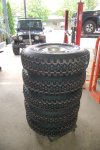Tried many tires and remember the 7.50 and 8.50 tires from back in the "50s and early '60s (no wish to revisit those low traction days).
Personally, since I am now older with, hopefully, more sense and (and disposable income), I really could care less about fuel mileage (if I wanted mileage I would not drive the TJR (but some under powered 2wd econobox instead).
For me tires are all about traction (for both on road braking and off road travel).
Since my legs are short I will sick with medium width (12.50 section, for the flotation) 33 inch mud tires... If I were to decide to go back onto the rocks I would install a tummy tuck/raise the engine, transmission and transfer case to approximate 35 inch tire clearance/break-over with the 33s..
If you want a bit better mileage, you can try using 2 sets of tires ('though switching them back and forth for off road trips is too much hassle for me).
For slightly better fuel mileage (but worse traction/braking (stopping distance), tire life, and ride; run the road tires near the top of their rated pressure on road.
Narrow tires can typically give better on road mileage than wider treads (though often worse braking) and, depending on the surface, can tend to sink/turn into trenching machines(get you stuck if there is no bottom, off road.
Lighter tires and wheels will typically improve braking (stopping distance) but since large, deep, tread blocks tend to weigh more, often have worse mud & loose terrain traction.
Fewer plies can contribute to lower weight but can result in punctured sidewalls; I do not use tires with fewer than 3 sidewall plies (actual not rated).
Enjoy!

